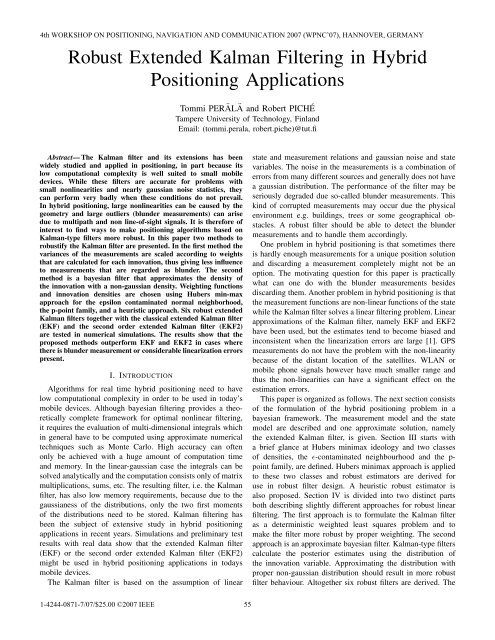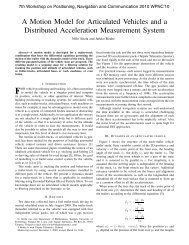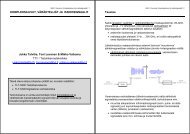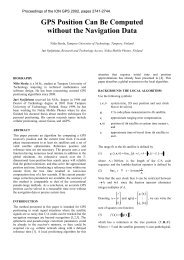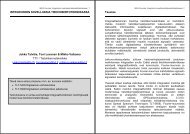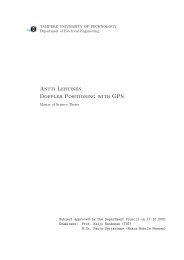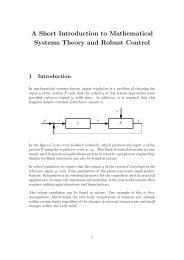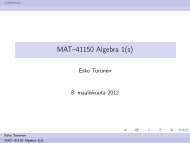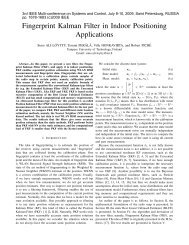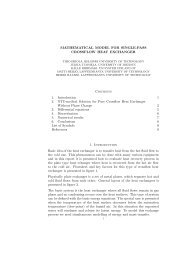Robust Extended Kalman Filtering in Hybrid Positioning Applications
Robust Extended Kalman Filtering in Hybrid Positioning Applications
Robust Extended Kalman Filtering in Hybrid Positioning Applications
Create successful ePaper yourself
Turn your PDF publications into a flip-book with our unique Google optimized e-Paper software.
4th WORKSHOP ON POSITIONING, NAVIGATION AND COMMUNICATION 2007 (WPNC’07), HANNOVER, GERMANY<br />
<strong>Robust</strong> <strong>Extended</strong> <strong>Kalman</strong> <strong>Filter<strong>in</strong>g</strong> <strong>in</strong> <strong>Hybrid</strong><br />
Position<strong>in</strong>g <strong>Applications</strong><br />
Abstract— The <strong>Kalman</strong> filter and its extensions has been<br />
widely studied and applied <strong>in</strong> position<strong>in</strong>g, <strong>in</strong> part because its<br />
low computational complexity is well suited to small mobile<br />
devices. While these filters are accurate for problems with<br />
small nonl<strong>in</strong>earities and nearly gaussian noise statistics, they<br />
can perform very badly when these conditions do not prevail.<br />
In hybrid position<strong>in</strong>g, large nonl<strong>in</strong>earities can be caused by the<br />
geometry and large outliers (blunder measurements) can arise<br />
due to multipath and non l<strong>in</strong>e-of-sight signals. It is therefore of<br />
<strong>in</strong>terest to f<strong>in</strong>d ways to make position<strong>in</strong>g algorithms based on<br />
<strong>Kalman</strong>-type filters more robust. In this paper two methods to<br />
robustify the <strong>Kalman</strong> filter are presented. In the first method the<br />
variances of the measurements are scaled accord<strong>in</strong>g to weights<br />
that are calculated for each <strong>in</strong>novation, thus giv<strong>in</strong>g less <strong>in</strong>fluence<br />
to measurements that are regarded as blunder. The second<br />
method is a bayesian filter that approximates the density of<br />
the <strong>in</strong>novation with a non-gaussian density. Weight<strong>in</strong>g functions<br />
and <strong>in</strong>novation densities are chosen us<strong>in</strong>g Hubers m<strong>in</strong>-max<br />
approach for the epsilon contam<strong>in</strong>ated normal neighborhood,<br />
the p-po<strong>in</strong>t family, and a heuristic approach. Six robust extended<br />
<strong>Kalman</strong> filters together with the classical extended <strong>Kalman</strong> filter<br />
(EKF) and the second order extended <strong>Kalman</strong> filter (EKF2)<br />
are tested <strong>in</strong> numerical simulations. The results show that the<br />
proposed methods outperform EKF and EKF2 <strong>in</strong> cases where<br />
there is blunder measurement or considerable l<strong>in</strong>earization errors<br />
present.<br />
I. INTRODUCTION<br />
Algorithms for real time hybrid position<strong>in</strong>g need to have<br />
low computational complexity <strong>in</strong> order to be used <strong>in</strong> today’s<br />
mobile devices. Although bayesian filter<strong>in</strong>g provides a theoretically<br />
complete framework for optimal nonl<strong>in</strong>ear filter<strong>in</strong>g,<br />
it requires the evaluation of multi-dimensional <strong>in</strong>tegrals which<br />
<strong>in</strong> general have to be computed us<strong>in</strong>g approximate numerical<br />
techniques such as Monte Carlo. High accuracy can often<br />
only be achieved with a huge amount of computation time<br />
and memory. In the l<strong>in</strong>ear-gaussian case the <strong>in</strong>tegrals can be<br />
solved analytically and the computation consists only of matrix<br />
multiplications, sums, etc. The result<strong>in</strong>g filter, i.e. the <strong>Kalman</strong><br />
filter, has also low memory requirements, because due to the<br />
gaussianess of the distributions, only the two first moments<br />
of the distributions need to be stored. <strong>Kalman</strong> filter<strong>in</strong>g has<br />
been the subject of extensive study <strong>in</strong> hybrid position<strong>in</strong>g<br />
applications <strong>in</strong> recent years. Simulations and prelim<strong>in</strong>ary test<br />
results with real data show that the extended <strong>Kalman</strong> filter<br />
(EKF) or the second order extended <strong>Kalman</strong> filter (EKF2)<br />
might be used <strong>in</strong> hybrid position<strong>in</strong>g applications <strong>in</strong> todays<br />
mobile devices.<br />
The <strong>Kalman</strong> filter is based on the assumption of l<strong>in</strong>ear<br />
1-4244-0871-7/07/$25.00 ©2007 IEEE<br />
Tommi PERÄLÄ and Robert PICHÉ<br />
Tampere University of Technology, F<strong>in</strong>land<br />
Email: (tommi.perala, robert.piche)@tut.fi<br />
55<br />
state and measurement relations and gaussian noise and state<br />
variables. The noise <strong>in</strong> the measurements is a comb<strong>in</strong>ation of<br />
errors from many different sources and generally does not have<br />
a gaussian distribution. The performance of the filter may be<br />
seriously degraded due so-called blunder measurements. This<br />
k<strong>in</strong>d of corrupted measurements may occur due the physical<br />
environment e.g. build<strong>in</strong>gs, trees or some geographical obstacles.<br />
A robust filter should be able to detect the blunder<br />
measurements and to handle them accord<strong>in</strong>gly.<br />
One problem <strong>in</strong> hybrid position<strong>in</strong>g is that sometimes there<br />
is hardly enough measurements for a unique position solution<br />
and discard<strong>in</strong>g a measurement completely might not be an<br />
option. The motivat<strong>in</strong>g question for this paper is practically<br />
what can one do with the blunder measurements besides<br />
discard<strong>in</strong>g them. Another problem <strong>in</strong> hybrid position<strong>in</strong>g is that<br />
the measurement functions are non-l<strong>in</strong>ear functions of the state<br />
while the <strong>Kalman</strong> filter solves a l<strong>in</strong>ear filter<strong>in</strong>g problem. L<strong>in</strong>ear<br />
approximations of the <strong>Kalman</strong> filter, namely EKF and EKF2<br />
have been used, but the estimates tend to become biased and<br />
<strong>in</strong>consistent when the l<strong>in</strong>earization errors are large [1]. GPS<br />
measurements do not have the problem with the non-l<strong>in</strong>earity<br />
because of the distant location of the satellites. WLAN or<br />
mobile phone signals however have much smaller range and<br />
thus the non-l<strong>in</strong>earities can have a significant effect on the<br />
estimation errors.<br />
This paper is organized as follows. The next section consists<br />
of the formulation of the hybrid position<strong>in</strong>g problem <strong>in</strong> a<br />
bayesian framework. The measurement model and the state<br />
model are described and one approximate solution, namely<br />
the extended <strong>Kalman</strong> filter, is given. Section III starts with<br />
a brief glance at Hubers m<strong>in</strong>imax ideology and two classes<br />
of densities, the ɛ-contam<strong>in</strong>ated neighbourhood and the ppo<strong>in</strong>t<br />
family, are def<strong>in</strong>ed. Hubers m<strong>in</strong>imax approach is applied<br />
to these two classes and robust estimators are derived for<br />
use <strong>in</strong> robust filter design. A heuristic robust estimator is<br />
also proposed. Section IV is divided <strong>in</strong>to two dist<strong>in</strong>ct parts<br />
both describ<strong>in</strong>g slightly different approaches for robust l<strong>in</strong>ear<br />
filter<strong>in</strong>g. The first approach is to formulate the <strong>Kalman</strong> filter<br />
as a determ<strong>in</strong>istic weighted least squares problem and to<br />
make the filter more robust by proper weight<strong>in</strong>g. The second<br />
approach is an approximate bayesian filter. <strong>Kalman</strong>-type filters<br />
calculate the posterior estimates us<strong>in</strong>g the distribution of<br />
the <strong>in</strong>novation variable. Approximat<strong>in</strong>g the distribution with<br />
proper non-gaussian distribution should result <strong>in</strong> more robust<br />
filter behaviour. Altogether six robust filters are derived. The
4th WORKSHOP ON POSITIONING, NAVIGATION AND COMMUNICATION 2007 (WPNC’07), HANNOVER, GERMANY<br />
results of simulation tests are discussed <strong>in</strong> section V.<br />
II. MODEL<br />
The state of the system at time tk (k =1, 2,...) is modelled<br />
as a stochastic variable xk. The evolution of the state <strong>in</strong> time<br />
is given by a stochastic difference equation<br />
xk+1 =g k(xk, wk) (1)<br />
and the <strong>in</strong>itial state x0 is assumed to be normally distributed<br />
with mean x0 and covariance matrix P0. The measurements<br />
yk are related to the state by<br />
yk =hk(xk, vk). (2)<br />
Here wk describes the noise <strong>in</strong> the state dynamics and vk<br />
the noise <strong>in</strong> the measurements. In this paper the noises are<br />
assumed to be white zero-mean mutually <strong>in</strong>dependent random<br />
processes, and also <strong>in</strong>dependent with the <strong>in</strong>itial state. Let<br />
y1:k = {yi,i =1,...,k} be the measurements before time<br />
step tk+1. The measurements used <strong>in</strong> this work are GPS<br />
pseudorange measurements and their derivatives, and base<br />
station range and altitude measurements. Because there is<br />
unknown clock bias <strong>in</strong> the satellite measurements, difference<br />
measurements are used <strong>in</strong>stead. One satellite is chosen as<br />
reference and all the differences are formed with respect to<br />
it. Let rk denote the position of the user, rs the position of<br />
the satellite (basestation) and rs0 the reference satellite. The<br />
range measurements are<br />
and the difference measurements<br />
hk+1(rk+1) =||rs − rk+1|| (3)<br />
hk+1(rk+1) =||rs − rk+1||−||rs0 − rk+1|| (4)<br />
The problem now is to solve the conditional probability density<br />
function (cpdf) of the posterior state, that is the cpdf of<br />
xk conditioned on y1:k = y1:k. Us<strong>in</strong>g the Bayes rule with<br />
the assumption of white noise sequences the cpdf may be<br />
formulated as<br />
p(xk|y1:k) = p(xk|y1:k−1)p(yk|xk)<br />
(5)<br />
p(yk|y1:k−1)<br />
where p(xk|y1:k−1) is the prior density, i.e. the cpdf of xk<br />
conditioned on y1:k−1 = y1:k−1, p(yk|xk) is the likelihood<br />
function giv<strong>in</strong>g the probability of measurement yk given state<br />
xk and p(yk|y1:k−1) is the predicted measurement density.<br />
To derive statistical quantities like mean and covariance from<br />
cpdf (5) requires <strong>in</strong>tegration of numerous multidimensional<br />
<strong>in</strong>tegrals us<strong>in</strong>g numerical <strong>in</strong>tegration methods. Grid based<br />
methods and sequential Monte Carlo (particle filter) methods<br />
have been used succesfully to calculate the posterior estimates.<br />
They however require a lot of computation and are not suitable<br />
<strong>in</strong> real time position<strong>in</strong>g with todays mobile devices. In the<br />
next section, one approximate analytic solution, namely the<br />
extended <strong>Kalman</strong> filter, is <strong>in</strong>troduced.<br />
56<br />
A. <strong>Extended</strong> <strong>Kalman</strong> Filter<br />
The extended <strong>Kalman</strong> filter is an approximate analytic<br />
solution to (5) if the noises wk and vk are additive gaussian<br />
noise sequences. The state and measurement functions are<br />
l<strong>in</strong>earized accord<strong>in</strong>g to<br />
Gk = ∂ g <br />
k(xk) <br />
∂xk<br />
,<br />
xk=ˆxk<br />
∂ hk(xk)<br />
<br />
<br />
Hk = <br />
∂xk xk=ˆx −<br />
k<br />
(6)<br />
where ˆx −<br />
k and ˆxk are the prior and posterior mean estimates<br />
at time step tk. The system model becomes<br />
xk+1 =Gkxk + wk<br />
yk =Hkxk + vk<br />
Now the prior density is gaussian with mean and covariance<br />
given as<br />
(7)<br />
(8)<br />
E(xk|y1:k−1) = ˆx −<br />
k = Gk ˆxk−1 (9)<br />
V(xk|y1:k−1) = ˆ P −<br />
k = Gk ˆ Pk−1G T k +Qk (10)<br />
where Qk is the covariance of wk. The posterior mean may<br />
be shown to be<br />
E(xk|y1:k) =ˆxk =ˆx −<br />
k + ˆ P −<br />
k HTk s(yk − Hk ˆx −<br />
k ) (11)<br />
where s(yk − Hk ˆx −<br />
k ) = −∇ ln p(yk|y1:k−1). Denot<strong>in</strong>g the<br />
covariance of vk with Rk the posterior mean becomes<br />
ˆxk =ˆx −<br />
k +Kk(yk − Hk ˆx −<br />
k<br />
and the posterior covariance is given by<br />
ˆPk =(I− KkHk) ˆ P −<br />
k<br />
) (12)<br />
(13)<br />
where Kk = ˆ P −<br />
k HT k (Hk ˆ P −<br />
k HT k +Rk) −1 is the <strong>Kalman</strong> ga<strong>in</strong><br />
matrix. Rk is assumed to be positive def<strong>in</strong>ite to make sure that<br />
the <strong>in</strong>verse exists.<br />
III. CLASSES OF DENSITIES<br />
As seen <strong>in</strong> the previous section, <strong>Kalman</strong> filter<strong>in</strong>g is based on<br />
the assumption of gaussian measurement noise and gaussian<br />
prior distribution. As argued before, the strict assumption of<br />
gaussian measurement noise may not be reasonable <strong>in</strong> hybrid<br />
position<strong>in</strong>g applications and therefore some ”more robust”<br />
densities are presented here.<br />
Huber [2] proposed a game where Nature choses the distribution<br />
F ∈ F and the eng<strong>in</strong>eer chooses the estimator<br />
T ∈T, and the asymptotic variance V(T,F) is the pay-off<br />
to the eng<strong>in</strong>eer. The asymptotic variance of an estimator is<br />
the variance of the estimator when the sample size tends to<br />
<strong>in</strong>f<strong>in</strong>ity. It can be shown that for certa<strong>in</strong> classes of distributions<br />
there exists a m<strong>in</strong>-max solution (T0,F0) such that<br />
m<strong>in</strong><br />
T ∈T max<br />
F ∈F V(T,F)=V(T0,F0) =max<br />
F ∈F m<strong>in</strong><br />
T ∈T V(T,F).<br />
F0 is called the least favorable distribution of class F and T0<br />
the m<strong>in</strong>-max robust estimator which is actually the maximum<br />
likelihood estimator for the least favorable density F0.
4th WORKSHOP ON POSITIONING, NAVIGATION AND COMMUNICATION 2007 (WPNC’07), HANNOVER, GERMANY<br />
A. The ɛ-contam<strong>in</strong>ated normal neighborhood<br />
Huber [2] considered the case<br />
contam<strong>in</strong>ated normal neighborhood<br />
where F is the ɛ-<br />
Fɛ = {F | F =(1−ɛ)φ + ɛH,<br />
H cont<strong>in</strong>uous symmetrical pdf}, (14)<br />
where φ is the standard normal probability density and H is a<br />
cont<strong>in</strong>uous symmetrical probability density function. The least<br />
favorable density for the ɛ-contam<strong>in</strong>ated normal neighborhood<br />
is<br />
p 0 <br />
(1−ɛ) 1<br />
√ − e 2<br />
ɛ(θ) = 2π θ2,<br />
|θ|≤ k<br />
(1−ɛ)<br />
√ e<br />
2π 1<br />
2 k2 (15)<br />
−k|θ| , |θ|> k<br />
where the threshold parameter k is given by<br />
2φ(k)<br />
ɛ<br />
− 2Φ(−k) =<br />
k 1 − ɛ<br />
(16)<br />
φ is the standard normal pdf and Φ the standard normal cdf.<br />
The correspond<strong>in</strong>g m<strong>in</strong>-max robust estimator is based on the<br />
maximization of the likelihood score of the least favorable<br />
density, namely<br />
sH(θ) = ∂<br />
∂θ ln p0 <br />
−θ,<br />
ɛ(θ) =<br />
−k sign(θ),<br />
|θ|≤ k<br />
|θ|> k<br />
(17)<br />
Filters us<strong>in</strong>g this score function are labelled ”H”.<br />
B. The p-po<strong>in</strong>t family<br />
Mart<strong>in</strong> and Masreliez [3] assert that if F is the p-po<strong>in</strong>t<br />
family<br />
−yp<br />
Fp = {F | F (θ)dθ = p/2 =Φ(−yp),<br />
−∞<br />
F symmetric and cont<strong>in</strong>uous at ± yp}, (18)<br />
where Φ is the standard normal cumulative distribution function,<br />
then the correspond<strong>in</strong>g least favorable density is given<br />
by<br />
p 0 <br />
2 θ K cos ( ), |θ|≤ yp<br />
2myp<br />
p(θ) =<br />
K cos2 ( 1<br />
2m )e2Kp−1 cos 2 ( 1<br />
2m )(yp−|θ|) , |θ|> yp<br />
(19)<br />
where K =(1−p)(yp(1 + m s<strong>in</strong>( 1<br />
m )))−1 and m is given by<br />
<br />
2m − p 1+tan 2<br />
<br />
1<br />
1<br />
2m +tan =0 (20)<br />
2m<br />
2m<br />
The likelihood score of the least favorable density of the ppo<strong>in</strong>t<br />
family Fp is<br />
sM(θ) = ∂<br />
∂θ ln p0 <br />
1 − myp<br />
p(θ) =<br />
tan( θ ), 2myp<br />
−<br />
|θ|≤ yp<br />
1<br />
C. Estimators without densities<br />
The m<strong>in</strong>-max robust estimators depend on the shape of<br />
the least favorable density. However, <strong>in</strong> more sophisticated<br />
robust filter design, it might be more appropriate to model the<br />
score function to correspond to the specific problem <strong>in</strong>stead<br />
of f<strong>in</strong>d<strong>in</strong>g the appropriate contam<strong>in</strong>ation classes and the least<br />
favorable densities. Andrews et. al [4] propose a three-partsredescend<strong>in</strong>g<br />
estimator which is basically a heuristic modification<br />
of the estimator proposed by Huber. Because redescend<strong>in</strong>g<br />
estimators reject certa<strong>in</strong> measurements a modified version of<br />
the three-parts-redescend<strong>in</strong>g estimator is proposed here. The<br />
score function is given by<br />
⎧<br />
⎨ θ, |θ|≤ k1<br />
sD(θ) = k1 sign(θ), k1 < |θ|≤ k2 (22)<br />
⎩ k1k2<br />
θ , |θ|> k2<br />
where the threshold parameters k1 and k2 are chosen to fit the<br />
problem. In this work k1 is solved as k <strong>in</strong> (16) and k2 =1.5k1.<br />
Filters us<strong>in</strong>g this score function are labelled ”D”.<br />
IV. ROBUST KALMAN FILTERING<br />
In the previous section we have def<strong>in</strong>ed some ”robust”<br />
densities and their correspond<strong>in</strong>g scores. In this section we<br />
proceed to describe two different ways that these could be<br />
used to robustify the extended <strong>Kalman</strong> filter.<br />
A. Weighted least squares filter<strong>in</strong>g<br />
The first approach is based on the robust <strong>Kalman</strong> filter<strong>in</strong>g<br />
studies of Carosio et. al [5]. The <strong>Kalman</strong> filter can be shown<br />
to be equivalent to a determ<strong>in</strong>istic least squares problem<br />
[6]. The filter is made more robust by replac<strong>in</strong>g the least<br />
squares score function by the score functions <strong>in</strong>troduced <strong>in</strong> the<br />
previous section. By approximat<strong>in</strong>g the derivative of the score<br />
function with a l<strong>in</strong>ear approximation the problem is modified<br />
to a weighted least squares problem, where the weights are<br />
calculated us<strong>in</strong>g the components of the <strong>in</strong>novation vector and<br />
a weight<strong>in</strong>g function that corresponds to the selected score<br />
function. This approach produces filters that give less <strong>in</strong>fluence<br />
to measurements that are classified as blunder.<br />
The state update equation and the measurement equation of<br />
the EKF given <strong>in</strong> (8) may be written as<br />
<br />
−<br />
I<br />
ˆx<br />
xk = k<br />
Gk−1(xk−1 − ˆxk−1)+wk−1<br />
+<br />
Hk yk<br />
−vk<br />
(23)<br />
To make the equations look more simple def<strong>in</strong>e<br />
<br />
Gk−1(xk−1 − ˆxk−1)+wk−1<br />
ek =<br />
(24)<br />
−vk<br />
Now<br />
E(ek) =0, V(ek) =E(eke<br />
1 tan( myp 2m )sign(θ),<br />
Filters us<strong>in</strong>g this score function are labelled ”M”.<br />
|θ|> yp<br />
(21)<br />
T <br />
ˆP −<br />
k )= k 0<br />
(25)<br />
0 Rk<br />
where ˆ P −<br />
k and Rk are symmetric positive def<strong>in</strong>ite and thus<br />
non-s<strong>in</strong>gular. Now def<strong>in</strong>e square matrix Mk such that<br />
M T −1<br />
ˆP −<br />
k Mk = k 0<br />
(26)<br />
57<br />
0 Rk
4th WORKSHOP ON POSITIONING, NAVIGATION AND COMMUNICATION 2007 (WPNC’07), HANNOVER, GERMANY<br />
Multiply<strong>in</strong>g (23) by<br />
Mk and def<strong>in</strong><strong>in</strong>g<br />
I<br />
Nk =Mk , ξk =Mkek, zk =Mk<br />
Hk<br />
zk =Nkxk + ξk<br />
ˆx −<br />
k<br />
yk<br />
<br />
yields<br />
(27)<br />
which is <strong>in</strong> the form of a standard l<strong>in</strong>ear least squares<br />
regression problem or equivalently<br />
n<br />
ˆxk =argm<strong>in</strong> ((zk)i − (N<br />
xk<br />
T k )ixk) 2<br />
(28)<br />
i=1<br />
where (NT k )i is the ith row of Nk. NowE(ξk) =0,<br />
V(ξk) =E(ξkξT k )=I, and the solution to (28) is given by<br />
ˆxk =(N T k Nk) −1 N T k zk =ˆx −<br />
k +Kk(yk − Hk ˆx −<br />
k<br />
) (29)<br />
which will be the posterior mean. The posterior covariance is<br />
chosen to be<br />
ˆPk =(N T k Nk) −1 =(I− KkHk) ˆ P −<br />
k<br />
(30)<br />
where Kk = ˆ P −<br />
k HT k (Hk ˆ P −<br />
k HT k +Rk) −1 is called the <strong>Kalman</strong><br />
ga<strong>in</strong> matrix. Equations (29) and (30) are of course similar to<br />
equations (12) and (13).<br />
Huber [2] <strong>in</strong>troduced a class of estimators, called Mestimators,<br />
that m<strong>in</strong>imize other functionals than the squares.<br />
Let ρ(·) denote the functional which will be m<strong>in</strong>imized. Now<br />
us<strong>in</strong>g ρ(·) <strong>in</strong> (28) <strong>in</strong> place of (·) 2 gives<br />
n<br />
ˆxk =argm<strong>in</strong> ρ((zk)i − (N<br />
xk<br />
T k )ixk) (31)<br />
i=1<br />
The m<strong>in</strong>imum is obta<strong>in</strong>ed by differentiat<strong>in</strong>g the functional to<br />
be m<strong>in</strong>imized with respect to (xk)j, j=1,...,nx and sett<strong>in</strong>g<br />
these partial derivatives equal to zero. Symbolically this can<br />
written as nx equations<br />
n<br />
(Nk)ijψj((zk)i − (N T k )iˆxk) =0, j =1,...,nx (32)<br />
i=1<br />
where ψj =(∇ρ)j and (Nk)ij is the ijth element of matrix<br />
Nk. The solution of (32) is somewhat difficult to obta<strong>in</strong> at<br />
least analytically because the ψ-functions may be non-l<strong>in</strong>ear.<br />
However, (32) can be approximated with a weighted least<br />
squares problem, namely<br />
n<br />
(Nk)ijωk,i((zk)i − (N T k )iˆxk) =0, j =1,...,nx (33)<br />
i=1<br />
where the weights ωk,i are given by<br />
<br />
ψi((zk)i−(N<br />
ωk,i =<br />
T<br />
k<br />
)i ˆx− k )<br />
(zk)i−(NT k<br />
)i ˆx− k<br />
, (zk)i = (NT −<br />
k )iˆx k<br />
1, (zk)i =(NT k<br />
Now the solution of (33) is given by<br />
)iˆx −<br />
k<br />
xk =(N T k ΩkNk) −1 N T k Ωkzk =ˆx −<br />
k +K∗k(yk − Hk ˆx −<br />
k<br />
with covariance<br />
ˆPk =(I− K ∗ kHk)P ∗ k<br />
(34)<br />
) (35)<br />
(36)<br />
58<br />
where K∗ k =P∗ kHT k (R∗ k +HkP∗ kHT k )−1 ,<br />
P∗ k =(ˆ P −<br />
k )1/2Ω −1<br />
k−1,1 (ˆ P −<br />
k )1/2 , R∗ k =R1/2<br />
k Ω−1<br />
k−1,2R1/2 k<br />
<br />
Ωk,1 0<br />
Ωk =diag(ωk,1,...,ωk,(nx+ny)) =<br />
0 Ωk,2<br />
<br />
(37)<br />
where the weights Ωk,1 ∈ R nx×nx and Ωk,2 ∈ R ny×ny . The<br />
motivation for divid<strong>in</strong>g the weight matrix <strong>in</strong>to two submatrices<br />
is that the Ωk,1 <strong>in</strong>fluences only the state update and Ωk,2 only<br />
the state correction with measurements. So if robustness is<br />
desired only <strong>in</strong> the measurement model one might want to<br />
def<strong>in</strong>e Ωk,1 =I. Depend<strong>in</strong>g on the application it might be<br />
reasonable to use different ψ-function for different components<br />
<strong>in</strong> (32).<br />
In this paper ψ(·) = −s(·), where the choices for the<br />
likelihood score s are given <strong>in</strong> equations (17), (21) and (22).<br />
Figure 1 shows the ψ-functions and the correspond<strong>in</strong>g weight<br />
functions. The filters us<strong>in</strong>g this method are denoted with prefix<br />
”WLS”.<br />
B. Bayesian filter<strong>in</strong>g assum<strong>in</strong>g non-gaussian <strong>in</strong>novation sequence<br />
The follow<strong>in</strong>g method is based on the results of Masreliez<br />
and Mart<strong>in</strong> [7]. Consider a transformed version of the measurement<br />
model <strong>in</strong> (8).<br />
Tkyk =TkHkxk +Tkvk<br />
(38)<br />
The transformation matrix Tk = (Hk ˆ P −<br />
k HT k +Rk) −1/2 is<br />
chosen such that TT k Tk =(Hk ˆ P −<br />
k HT k +Rk) −1 , which is easily<br />
obta<strong>in</strong>ed for example us<strong>in</strong>g the s<strong>in</strong>gular value decomposition.<br />
Thus the transformed <strong>in</strong>novation variable has a standard normal<br />
density distribution.<br />
The <strong>Kalman</strong> filter calculates the posterior state estimates<br />
us<strong>in</strong>g the <strong>in</strong>novation variable. Under the transformed measurement<br />
model (38) the posterior mean is given by<br />
ˆxk =ˆx −<br />
k + ˆ P −<br />
k HT k T T k s(nk) (39)<br />
where the score s(nk) =−∇ ln p(yk|y1:k−1)|yk=nk and<br />
nk =Tk(yk−Hk ˆx −<br />
) is the transformed <strong>in</strong>novation. Masreliez<br />
k<br />
and Mart<strong>in</strong> assert that if p(yk|y1:k−1) is the least favorable<br />
density of either Fɛ or Fp then the posterior mean is given as<br />
<strong>in</strong> (39) and the posterior covariance is given by<br />
ˆPk =(I−KkHk E p(yk|y1:k−1)∇s T <br />
(yk)|yk=nk ) Pˆ −<br />
k (40)<br />
If s = sH or s = sD, then<br />
E p(yk|y1:k−1)∇s T <br />
(yk)|yk=nk =<br />
<br />
p(yk|y1:k−1)∇s T (yk)|yk=nk dyk =1− 2Φ(k) (41)<br />
and if s = sM , then<br />
E p(yk|y1:k−1)∇s T <br />
(yk)|yk=nk =<br />
(myp) −2 (1 − p(1 + tan 2 ( 1<br />
)) (42)<br />
2m<br />
The filters us<strong>in</strong>g this method are denoted with prefix ”B”
4th WORKSHOP ON POSITIONING, NAVIGATION AND COMMUNICATION 2007 (WPNC’07), HANNOVER, GERMANY<br />
V. TESTING<br />
The robust methods were implemented <strong>in</strong> a MATLAB simulation<br />
test bench for comparison between different filters. The<br />
simulation test bench was designed to produce dynamic test<br />
data similar to what could be expected <strong>in</strong> real-world personal<br />
position<strong>in</strong>g scenario. The ma<strong>in</strong> difference from the real data is<br />
that <strong>in</strong> the simulation the true track and correct measurement<br />
and motion models are available. The test<strong>in</strong>g process consists<br />
of first generat<strong>in</strong>g a true track of 100 po<strong>in</strong>ts at one second<br />
<strong>in</strong>tervals with a velocity-restricted random walk model, then<br />
generat<strong>in</strong>g a set of base station (BS) along the track with<br />
maximum ranges set so that one to three stations can be heard<br />
from every po<strong>in</strong>t on the track. A GPS constellation is then<br />
simulated with an elevation mask and shadow<strong>in</strong>g profile set<br />
so that only a couple of satellites are visible at a time. F<strong>in</strong>ally,<br />
noisy measurements are generated for each time step from<br />
the visible satellite ranges and delta-ranges, and base stations<br />
ranges and altitude measurements. If probability for blunder<br />
measurement b is greater than zero, then every generated<br />
measurement fails with a probability of b.<br />
Several track and measurement sets were generated with different<br />
measurement sources, measurement noises and blunder<br />
measurement probabilities. The result<strong>in</strong>g test bench consists<br />
of two different sets accord<strong>in</strong>g to two different choices for<br />
the blunder measurement probability (0.00 and 0.05). Each<br />
set has base station and satellite geometries for 9 cases<br />
represent<strong>in</strong>g different difficult position<strong>in</strong>g situations accord<strong>in</strong>g<br />
to the follow<strong>in</strong>g table<br />
mean # BS mean # GPS<br />
Case 1 0.5 0<br />
Case 2 1.5 0<br />
Case 3 2.5 0<br />
Case 4 0.5 2<br />
Case 5 1.5 2<br />
Case 6 2.5 2<br />
Case 7 0 2.5<br />
Case 8 0 3.5<br />
Case 9 0 5<br />
Every case conta<strong>in</strong>es 100 tracks, which all have the length of<br />
100 time steps.<br />
The test tracks were filtered with the six robust filters of<br />
this paper, and the mean and covariance of the posterior<br />
distribution recorded at each time step. The filtered solutions<br />
were compared to the true track and some statistics derived.<br />
The filter’s ability to identify blunder measurements was<br />
also tested and reported. For comparison, the data was also<br />
processed with EKF and EKF2 [1].<br />
A. Results<br />
The results of the test bench may be seen <strong>in</strong> tables I and II.<br />
The quantities calculated are the mean 2D error (MSE) given<br />
<strong>in</strong> meters, the bound below which are 95% of the errors, and<br />
the frequency of <strong>in</strong>consistent estimates. A Filter is said to<br />
be <strong>in</strong>consistent if the error estimate is smaller than the actual<br />
error. For discussion on the consistency of EKF and EKF2 see<br />
59<br />
[1]. As expected all the B-filters outperform EKF and EKF2<br />
<strong>in</strong> contam<strong>in</strong>ated cases. It is <strong>in</strong>terest<strong>in</strong>g to notice however,<br />
that when there are GPS measurements available the WLSfilters<br />
fail compeletely. In basestation only cases the WLSsolvers<br />
sometimes outperform even the B-filters. The WLS<br />
filters’ failure seems to be caused by the large <strong>in</strong>novations that<br />
sometimes occur with GPS-measurements. The solvers may<br />
easily give a weight of less than 0.01 for some measurements.<br />
The filters’ ability to detect the correct corrupted measurement<br />
was also quite poor. On average the filters identify wrong<br />
measurement more often than the right measurement, and<br />
this becomes a serious problem with the WLS-filters, because<br />
correct measurements get scaled close to zero. All that can<br />
be said about the blunder detection is, that it is extremely<br />
hard to tell if a measurement is a blunder measurement by<br />
measur<strong>in</strong>g the magnitude of the correspond<strong>in</strong>g <strong>in</strong>novation -<br />
the prior might also be wrong, but the filter <strong>in</strong>dentifies the<br />
measurements as blunder. In tables III and IV are listed how<br />
well the filters detect and identify blunder measurements. The<br />
actions of the filter may be divided <strong>in</strong>to five categories:<br />
I Blunder measurements are present and the filter detects<br />
them correctly. Filter calculates robust estimates.<br />
II Blunder measurements are present but the filter identifies<br />
wrong measurement.<br />
III Blunder measurements are present but the filter does not<br />
notice it, thus work<strong>in</strong>g as EKF.<br />
IV False alarm. No blunder measurements, but filter calculates<br />
robust estimates.<br />
V No blunder measurements and no action. This means that<br />
the filters, except the filters based on the p-po<strong>in</strong>t score,<br />
work as EKF.<br />
The frequencies of categories 1-4 are listed <strong>in</strong> the table<br />
and the categories are denoted by the correspond<strong>in</strong>g Roman<br />
numeral. The frequency of category 5 is the frequency of the<br />
complement of the union of the three first categories. The<br />
False alarms occur quite often, but they are not very dangerous<br />
except for WLS-filters with GPS-measurements. If there were<br />
blunder measurements present, the filters detected them almost<br />
every time. The most <strong>in</strong>terest<strong>in</strong>g th<strong>in</strong>g however is the huge<br />
frequency of category 2 <strong>in</strong> the contam<strong>in</strong>ated case. Because<br />
the false alarm is the only one from the categories 1-4 which<br />
can happen <strong>in</strong> the uncontam<strong>in</strong>ated case, the zero frequencies<br />
are left out from table III.<br />
VI. CONCLUSION<br />
Based on the simulations, the proposed methods seem to<br />
outperform EKF and EKF2 <strong>in</strong> contam<strong>in</strong>ated cases and do<br />
almost as well <strong>in</strong> normal cases. Therefore, the proposed methods<br />
should be taken <strong>in</strong>to consideration to be used <strong>in</strong> mobile<br />
position<strong>in</strong>g devices. The approximate bayesian filter is to be<br />
preferred over the WLS-filter if there are GPS-measurements<br />
available. WLS-filters might be considered otherwise. The<br />
score functions should be chosen based on empirical measurement<br />
data, but without any prelim<strong>in</strong>ary knowledge of the<br />
situation it seems to be safe to use any of the scores proposed<br />
here. However, the modified Hampel estimator seems to give
4th WORKSHOP ON POSITIONING, NAVIGATION AND COMMUNICATION 2007 (WPNC’07), HANNOVER, GERMANY<br />
best estimates. More sophisticated robust filter should be able<br />
to <strong>in</strong>dentify certa<strong>in</strong> situations and apply the most convenient<br />
robust model to them, but this is beyond the scope of this<br />
paper and left for future study.<br />
ACKNOWLEDGMENT<br />
This study was funded by Nokia Corporation. The EKF<br />
and EKF2 used for reference were implemented by Simo Ali-<br />
Löytty and the simulation test bench was generated us<strong>in</strong>g Niilo<br />
Sirola’s test bench generator [8].<br />
REFERENCES<br />
[1] S. Ali-Löytty, N. Sirola, and R. Piché, “Consistency of Three <strong>Kalman</strong><br />
Filter Extensions <strong>in</strong> <strong>Hybrid</strong> Navigation,” <strong>in</strong> Proceed<strong>in</strong>gs of the European<br />
Navigation Conference GNSS, July 19-22 2005.<br />
[2] P. J. Huber, “<strong>Robust</strong> Estimation of a Location Parameter,” Ann. Math.<br />
Statis., vol. 35, pp. 73–101, 1964.<br />
[3] R. D. Mart<strong>in</strong> and C. J. Masreliez, “<strong>Robust</strong> Estimation via Stochastic<br />
Approximation,” IEEE Transactions on Information Theory, vol. IT-21,<br />
no. 3, pp. 263–271, May 1975.<br />
[4] D. F. Andrews, P. J. Bickel, F. R. Hampel, P. J. Huber, W. H. Rogers,<br />
andJ.W.Tukey,<strong>Robust</strong> Estimates of Location: Survey and Advances.<br />
Pr<strong>in</strong>ceton University Press, 1972.<br />
[5] A. Carosio, A. C<strong>in</strong>a, and M. Piras, “The <strong>Robust</strong> Statistics Method<br />
Applied to the <strong>Kalman</strong> Filter: Theory and Application,” ION GNSS 18th<br />
International Technical Meet<strong>in</strong>g of the Satellite Division, September 13-<br />
16 2005.<br />
[6] A. E. Bryson and Y.-C. Ho, Applied Optimal Control: Optimization,<br />
Estimation, and Control. Taylor & Francis, 1975.<br />
[7] C. J. Masreliez and R. D. Mart<strong>in</strong>, “<strong>Robust</strong> Bayesian Estimation for the<br />
L<strong>in</strong>ear Model and <strong>Robust</strong>ify<strong>in</strong>g the <strong>Kalman</strong> Filter,” IEEE Transactions<br />
on Automatic Control, vol. AC–22, no. 3, pp. 361–371, 1977.<br />
[8] N. Sirola, S. Ali-Löytty, and R. Piché, “Benchmark<strong>in</strong>g nonl<strong>in</strong>ear filters,”<br />
<strong>in</strong> Nonl<strong>in</strong>ear Statistical Signal Process<strong>in</strong>g Workshop NSSPW06, Cambridge,<br />
September 2006.<br />
60
4th WORKSHOP ON POSITIONING, NAVIGATION AND COMMUNICATION 2007 (WPNC’07), HANNOVER, GERMANY<br />
−k2<br />
−k<br />
−y<br />
−k1<br />
ψH(t)<br />
k<br />
−k<br />
ψM(t)<br />
y<br />
−y<br />
ωD(t)<br />
1<br />
k<br />
y<br />
k1<br />
k2<br />
t<br />
Fig. 1. The ψ- and the ω-functions<br />
t<br />
t<br />
61<br />
−k2<br />
−k1<br />
ψD(t)<br />
k1<br />
−k1<br />
ωH(t)<br />
1<br />
−k k<br />
ωM (t)<br />
1<br />
−y y<br />
k1<br />
k2<br />
t<br />
t<br />
t
4th WORKSHOP ON POSITIONING, NAVIGATION AND COMMUNICATION 2007 (WPNC’07), HANNOVER, GERMANY<br />
TABLE I<br />
RESULTS OF THE TESTBENCH WITH BLUNDER PROB. b =0.00<br />
Case 1 Case 2 Case 3<br />
b =0% MSE 95% <strong>in</strong>con MSE 95% <strong>in</strong>con MSE 95% <strong>in</strong>con<br />
EKF 129 490 14.7 40 138 3.8 11 29 0.0<br />
EKF2 123 453 3.8 45 172 2.2 11 29 0.0<br />
BHA 138 534 15.3 47 168 4.8 12 30 0.0<br />
BH 135 510 15.0 43 156 4.5 12 30 0.0<br />
BM 132 518 14.8 44 152 4.3 12 30 0.0<br />
WLSHA 144 532 16.0 43 155 4.1 12 31 0.0<br />
WLSH 132 493 14.9 39 137 3.4 12 30 0.0<br />
WLSM 133 505 15.3 40 141 3.8 12 30 0.1<br />
Case 4 Case 5 Case 6<br />
MSE 95% <strong>in</strong>con MSE 95% <strong>in</strong>con MSE 95% <strong>in</strong>con<br />
EKF 13 33 0.1 9 20 0.0 20 68 0.8<br />
EKF2 13 33 0.0 9 20 0.0 19 64 0.3<br />
BHA 13 33 0.1 9 20 0.0 23 76 1.4<br />
BH 13 34 0.1 9 20 0.0 22 75 1.4<br />
BM 13 50 0.4 9 20 0.0 21 70 1.2<br />
WLSHA 13 34 0.1 9 20 0.0 21 71 0.9<br />
WLSH 13 33 0.1 9 20 0.0 21 70 1.0<br />
WLSM 13 56 0.2 9 20 0.0 21 70 1.0<br />
Case 7 Case 8 Case 9<br />
MSE 95% <strong>in</strong>con MSE 95% <strong>in</strong>con MSE 95% <strong>in</strong>con<br />
EKF 18 41 0.0 19 43 0.0 17 37 0.0<br />
EKF2 18 41 0.0 19 43 0.0 17 37 0.0<br />
BHA 19 42 0.0 19 44 0.0 17 38 0.0<br />
BH 19 42 0.0 19 44 0.0 17 38 0.0<br />
BM 19 42 0.0 19 44 0.0 17 38 0.0<br />
WLSHA 19 42 0.0 19 43 0.0 17 37 0.0<br />
WLSH 19 42 0.0 19 43 0.0 17 37 0.0<br />
WLSM 19 42 0.0 19 43 0.0 17 38 0.0<br />
TABLE II<br />
RESULTS OF THE TESTBENCH WITH BLUNDER PROB. b =0.05<br />
Case 1 Case 2 Case 3<br />
b =5% MSE 95% <strong>in</strong>cons. MSE 95% <strong>in</strong>cons. MSE 95% <strong>in</strong>cons.<br />
EKF 351 1466 42.0 168 693 38.6 85 328 35.2<br />
EKF2 329 1317 37.6 163 667 35.3 84 326 35.0<br />
BHA 162 656 15.5 89 416 9.7 14 35 0.6<br />
BH 177 667 18.5 91 433 11.2 15 40 1.1<br />
BM 193 804 21.1 88 403 12.4 16 42 1.5<br />
WLSHA 170 725 16.4 90 437 9.0 12 30 0.0<br />
WLSH 169 667 17.7 83 414 9.3 14 34 0.2<br />
WLSM 171 653 18.6 79 385 9.5 14 36 0.2<br />
Case 4 Case 5 Case 6<br />
MSE 95% <strong>in</strong>cons. MSE 95% <strong>in</strong>cons. MSE 95% <strong>in</strong>cons.<br />
EKF 503 1491 86.5 317 1033 79.2 372 1248 71.6<br />
EKF2 502 1491 86.5 317 1033 79.2 370 1242 71.1<br />
BHA 17 42 0.1 12 29 0.5 21 60 0.9<br />
BH 20 51 0.1 14 36 1.6 32 73 2.6<br />
BM 21 53 1.6 15 39 2.4 34 82 3.8<br />
WLSHA 2397 10689 86.0 2150 10283 78.2 4090 19335 72.7<br />
WLSH 855 1413 84.1 548 1996 75.6 737 2877 68.7<br />
WLSM 762 2351 84.2 487 1815 75.2 696 2574 68.2<br />
Case 7 Case 8 Case 9<br />
MSE 95% <strong>in</strong>cons. MSE 95% <strong>in</strong>cons. MSE 95% <strong>in</strong>cons.<br />
EKF 1020 3065 92.3 989 2705 93.8 949 2548 95.5<br />
EKF2 1020 3065 92.3 989 2705 93.8 949 2548 95.5<br />
BHA 25 59 0.3 23 49 0.0 21 45 0.0<br />
BH 28 68 0.4 26 56 0.3 26 57 1.0<br />
BM 30 73 0.9 27 60 0.8 28 61 2.1<br />
WLSHA 7090 25138 90.5 6787 26024 92.5 3839 15123 94.2<br />
WLSH 2351 7926 90.7 2013 6255 93.0 1734 5530 94.8<br />
WLSM 2283 7617 90.4 1873 6032 93.1 1615 4936 94.9<br />
62
4th WORKSHOP ON POSITIONING, NAVIGATION AND COMMUNICATION 2007 (WPNC’07), HANNOVER, GERMANY<br />
TABLE III<br />
BLUNDER DETECTION WITH BLUNDER PROBABILITY b =0.00<br />
Case 1 Case 2 Case 3 Case 4 Case 5 Case 6 Case 7 Case 8 Case 9<br />
b =0% III III III III III III III III III<br />
BHA 0.21 0.28 0.37 0.45 0.55 0.33 0.30 0.41 0.59<br />
BH 0.21 0.27 0.37 0.45 0.55 0.33 0.30 0.41 0.59<br />
BM 0.22 0.29 0.39 0.46 0.56 0.34 0.30 0.41 0.59<br />
WLSHA 0.38 0.43 0.52 0.58 0.66 0.47 0.46 0.57 0.70<br />
WLSH 0.37 0.42 0.51 0.58 0.66 0.47 0.46 0.57 0.70<br />
WLSM 0.37 0.42 0.51 0.58 0.66 0.47 0.47 0.57 0.70<br />
TABLE IV<br />
BLUNDER DETECTION WITH BLUNDER PROBABILITY b =0.05<br />
Case 1 Case 2 Case 3<br />
b =5% I II III IV I II III IV I II III IV<br />
BHA 0.01 0.03 0.02 0.25 0.02 0.04 0.02 0.30 0.03 0.06 0.03 0.41<br />
BH 0.01 0.03 0.01 0.27 0.02 0.04 0.02 0.32 0.03 0.06 0.02 0.44<br />
BM 0.01 0.03 0.01 0.29 0.02 0.04 0.02 0.34 0.03 0.06 0.02 0.45<br />
WLSHA 0.02 0.02 0.01 0.40 0.03 0.03 0.01 0.42 0.03 0.06 0.02 0.50<br />
WLSH 0.02 0.02 0.01 0.42 0.03 0.03 0.01 0.44 0.03 0.06 0.02 0.52<br />
WLSM 0.02 0.02 0.01 0.42 0.03 0.03 0.01 0.44 0.03 0.06 0.02 0.52<br />
Case 4 Case 5 Case 6<br />
I II III IV I II III IV I II III IV<br />
BHA 0.07 0.11 0.09 0.45 0.09 0.16 0.09 0.47 0.05 0.08 0.09 0.39<br />
BH 0.08 0.11 0.09 0.46 0.09 0.17 0.08 0.48 0.05 0.08 0.08 0.41<br />
BM 0.08 0.11 0.09 0.47 0.09 0.17 0.08 0.49 0.05 0.08 0.08 0.42<br />
WLSHA 0.22 0.05 0.00 0.70 0.25 0.08 0.01 0.65 0.15 0.04 0.01 0.69<br />
WLSH 0.22 0.05 0.01 0.69 0.24 0.08 0.01 0.64 0.15 0.05 0.01 0.68<br />
WLSM 0.22 0.06 0.00 0.70 0.23 0.09 0.01 0.64 0.15 0.05 0.01 0.67<br />
Case 7 Case 8 Case 9<br />
I II III IV I II III IV I II III IV<br />
BHA 0.08 0.14 0.03 0.27 0.10 0.19 0.02 0.31 0.16 0.25 0.01 0.37<br />
BH 0.08 0.14 0.02 0.29 0.11 0.18 0.02 0.33 0.16 0.25 0.01 0.39<br />
BM 0.08 0.14 0.02 0.30 0.10 0.19 0.02 0.34 0.16 0.25 0.01 0.40<br />
WLSHA 0.24 0.01 0.00 0.72 0.30 0.01 0.00 0.67 0.41 0.01 0.00 0.57<br />
WLSH 0.24 0.01 0.00 0.72 0.30 0.01 0.00 0.67 0.41 0.01 0.00 0.57<br />
WLSM 0.24 0.01 0.00 0.71 0.30 0.01 0.00 0.67 0.41 0.01 0.00 0.57<br />
63


